- Created and published by Chaosium
- Authors: Chris Lackey, Mike Mason
- Cover Artist: Loïc Muzy
- Interior Artists: Alberto Bontempi, Thomas Brown, Irene Cano, Kristina Carroll, Caleb Cleveland, Stephen Cornu, Kring Demetrio, Emanuele Desiati, Michael Ellis, Andrey Fetisov, Doruk Golcu, Nicholas Grey, Patrik Hell, Kali Houisse, Pat Loboyko, Sam Lotfi, Ernest Mason, Loïc Muzy, Aleks Shcherbakov, John Sumrow, Johnathan Torres, Arrigo Verderosa
- Cartography and Handouts: Matt Ryan
- Layout: Nicholas Nacario
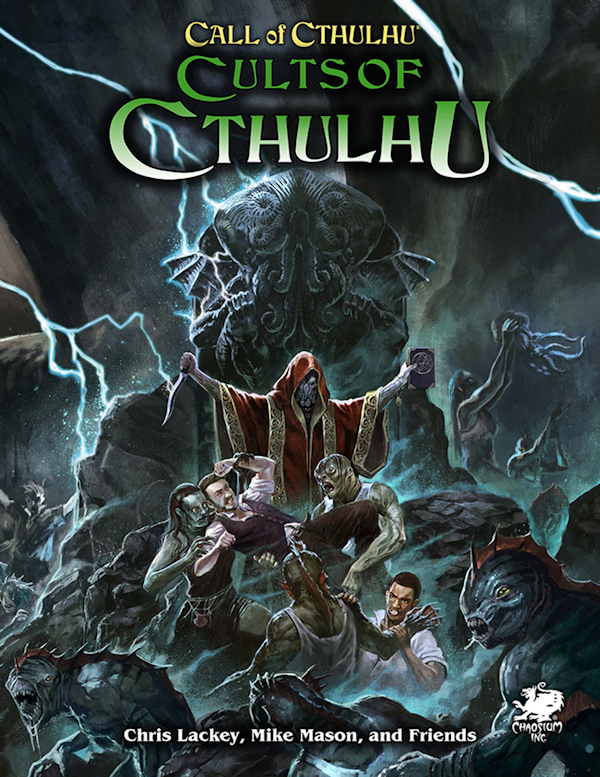 Cults of Cthulhu is a supplement for Call of Cthulhu—the first and most famous Lovecraftian role playing game. (To my knowledge, the first horror RPG ever.) Cults of Cthulhu recently won a Golden Ennie award, which may be all the review you need. But if you want to know more, let me briefly establish my credentials, or lack thereof.
Cults of Cthulhu is a supplement for Call of Cthulhu—the first and most famous Lovecraftian role playing game. (To my knowledge, the first horror RPG ever.) Cults of Cthulhu recently won a Golden Ennie award, which may be all the review you need. But if you want to know more, let me briefly establish my credentials, or lack thereof.
I’m an interested and informed outsider to this venerable game. I’ve played it quite a bit, read a lot of weird fiction, consumed a huge amount of Call of Cthulhu media (let’s plays, reviews, discussions), and many games with Lovecraftian/cosmic horror themes. But I’ve never been a Keeper of Arcane Lore (as the GM of a Call of Cthulhu game is grandly titled), and this is the first Chaosium product I’ve ever reviewed.
I will be talking about what this book provides for Keepers, but also what other people could take from it or use it for.
So, what does Cults of Cthulhu provide?
I’d imagined it would be a gazetteer of many different cults from across the world and from many different historical eras, perhaps even venturing off-planet. An isolated Japanese mountain village in thrall to an undying priest. A unit of U.S. Marines who adopted a stone idol as a good luck charm, but now find themselves compelled to anoint it with blood. An ancient city in what would become Nigeria, that was overwhelmed by inhuman forces. Hideous rites performed by nameless beings on a planet no human has ever charted. This isn’t that, though it does nod to it.
Cults of Cthulhu is a Keeper’s guide to placing Cthulhu and its human worshippers at the centre of their games. It contains:
- A brief timeline of Cthulhu cults and cultists across time.
- Detailed descriptions of five Cthulhu cults (two from the original literature and three new cults). Each cult is from a different place and time, though they are all based in Britain or the USA.
- Extensive and well-versed information on creating your own Cthulhu cult.
- New monsters and NPCs who owe allegiance to Cthulhu, or at least work with his cultists. Plus, a handful of Cthulhu artefacts.
- A very well-crafted set of three scenarios based around the three new cults, complete with extensive handouts.
There is a wide variety of artwork throughout. I’ve never seen so many different interpretations of Cthulhu! From epic eldritch action shots to depictions so grotty and slimy you’ll want to have a bath after looking at them, to hauntingly alien and creepy images that speak of cosmic menace.
Introduction
A solid introduction breaks down what to expect from each chapter. It also proclaims that cultists are the most frightening monsters of all because they are what we could become—inciting both disgust and sympathy even as they plot to destroy us all.
Chapter One: History of the Cthulhu Cult
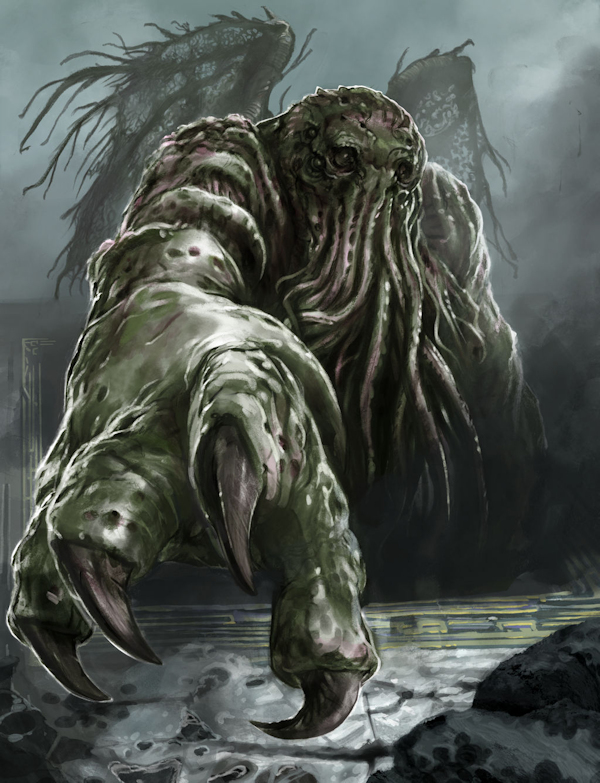 This is a mostly “in-universe” description, timeline, and discussion of the Cthulhu Cult and its influence. Chaosium still place considerable emphasis on the original Cthulhu stories (Call of Cthulhu and The Shadow Over Innsmouth) and use them as a jumping off point. They do have some very interesting thoughts about these stories, however. For example, when the crew of the Alert rammed Cthulhu and temporarily dispersed him, was that just a projection of the real Cthulhu? Was the entire encounter just a shared dream caused by sailing too close to R’lyeh?
This is a mostly “in-universe” description, timeline, and discussion of the Cthulhu Cult and its influence. Chaosium still place considerable emphasis on the original Cthulhu stories (Call of Cthulhu and The Shadow Over Innsmouth) and use them as a jumping off point. They do have some very interesting thoughts about these stories, however. For example, when the crew of the Alert rammed Cthulhu and temporarily dispersed him, was that just a projection of the real Cthulhu? Was the entire encounter just a shared dream caused by sailing too close to R’lyeh?
From there, the chapter delves into examples of presumed Cthulhu worship going back as far as plagues of madness in ancient Sumer, and continuing up to the modern day, with modern cultists facing off with U.S. law enforcement and committing mass suicide. Highlights include but are not limited to:
- The subterranean realm of Xinaián, in what became Oklahoma.
- The Cult of Vasavasamudram, a group based in India whose adherents engaged in ritual self-mutilation.
- Three 14th Century Bavarian monks who cured a dozen people of the deadly “dancing plague” with a mysterious alien chant.
- The Ghost Eaters of China.
- “The Box Elder Monster,” a 50-foot-high statue of Cthulhu made of old tires. This is absolute genius and I salute whichever writer came up with it.
- Kanaloa Rising, a psychedelic jazz fusion rock band who were seemingly influenced by Cthulhu. Also, genius.
In terms of game use, none of these are much more than plot seeds or tall tales. But they’re decent source of inspiration for any Keeper who enjoys researching history and wants to set an adventure or campaign somewhere a bit different.
I would have liked some more obvious plot hooks, e.g., the mummified body of one of those monks sits in the British Museum to this day, or no one knows what happened to the leader of Cult of Vasavasamudram. Most likely these tales will be used to provide background for games set in the 1920s or the modern day.
Although there’s plenty of variety here, I would have also liked some even stranger and more original descriptions of Cthulhu. Why couldn’t Cthulhu be worshipped as a giant tentacled slug, or something like that? There’s too much consensus about the squid-headed, dragon-winged humanoid entity, basically. Most of the cults even use recognisable names and spellings for this alien, famously unpronounceable god.
The writers do present different interpretations of the cult, allowing Keepers to decide how organised it is. Is it a single organisation stretching across continents and millennia, with a direct line to old squid-face himself? A scattered collection of isolated or even warring cults, each one failing to grasp the true meaning of Cthulhu? Or something else? This is a tool for Keepers to use to build their own world of cosmic horror, not a rigid setting.
The writers also suggest a Keeper should focus on a cult’s goals but shouldn’t necessarily worry about the end point of those goals, and certainly shouldn’t worry about the aims of Cthulhu himself, which are unknowable. This is very much reflected in the scenarios later on in the book.
Chapter Two: Cults of Cthulhu
[Spoiler Note: Players, I’ve tried to keep spoilers light, but even knowing that some of these cults exist is a spoiler. You have been warned.]
The five cults presented here are:
- Elevated Order of Morpheus (1890s, London)
- Louisiana Swamp Cult (1900s)
- Society of the Angelic Ones (1920s California)
- Esoteric Order of Dagon (1920s Massachusetts, specifically the fictional town of Innsmouth)
- Church of Perfect Science (Modern, based in the USA but with international influence)
Extensive backgrounds are provided for each cult, along with their structure, organisation, goals, key NPCs, and some very practical details such as where they get their money from. Each cult description is rich with possible clues that could set investigators on their trail—disappearances, murders, unsavoury recruitment practices, strange rituals, criminal activities and temples both hidden and obvious. The writers provide a couple of example scenario seeds for each cult as well. As well as being very useful for running these specific cults as antagonists in an adventure, these breakdowns are excellent examples that teach a budding Keeper how to construct and think about their own fictional cults.
The Swamp Cult and Order of Dagon are drawn from the Call of Cthulhu and The Shadow Over Innsmouth respectively. If you want to create your own adventures based around those stories, this chapter gives you all the NPCs, grisly details and practical information you might need. I did like the slight reimagining of the Order of Dagon as an organisation that is actively seeking to spread its influence to other towns and even cities. This makes them a much better antagonist for pulp investigators, or as the focus of an entire campaign.
However, I was more interested in the three new cults.
The Elevated Order of Morpheus is a Victorian occult brotherhood/secret society in thrall to Cthulhu’s influence. Its members are rich and powerful and carry out all sorts of weird experiments and skulduggery, meaning the cult can turn out to have been the driving force behind many different minor villains and eldritch happenings. I liked the fact that the cult’s leader may be outgrowing it, and the possibilities for internal conflict that opens up.
The Society of the Angelic Ones was founded by a con artist and black widow and is fronted by her “prophet” daughter. Claiming to be a sect of Christianity, its worship is based around “angels”, which are actually Cthulhu Mythos creatures. Most members haven’t even heard of Cthulhu, but higher-ranking members will endure a series of increasingly weird and nasty rituals, encountering the Mythos again and again until their hands are red with blood and their minds are filled with alien wisdom. Another juicy internal conflict has been set up within this cult.
Perhaps most interesting, is the Church of Perfect Science. Initially founded by a science fiction writer turned self-help guru and occult philosopher, it offers to improve its members’ lives through a system called Processing. It has branches all over the world, and has attracted considerable attention, as well as accumulating considerable wealth and influence. The Church experiments with strange alien technology, and the ultimate end goal of Processing is very weird indeed. It really felt to me as though the writers were taking the Mythos in a new direction with this cult (fans of Delta Green may disagree).
One thing that makes the Church particularly interesting is this line, “The Church does not see Cthulhu as a master to be served, but as a being of ultimate enlightenment to be emulated.”
Though they, ostensibly, worship Cthulhu, the Church has no interest in bringing about the apocalypse; they intend to survive it and save humanity in the process. The writers point out that although the Church’s actions are shadowy, manipulative and often villainous, it might be right. Cthulhu will win in the end, Call of Cthulhu the RPG has always been clear about that, so perhaps any evil might be justified in the name of survival. That is something for Keepers and players to wrestle with in game.
Chapter Three: Creating a Cthulhu Cult
“What? could possibly drive a person to such dark, horrific depths? That? is a question that should plague the investigators—and their ?players—throughout the game.”
 This chapter begins with ruminations on the true nature of the Cthulhu cult, and some alternative interpretations of its purpose. A Cthulhu cult could have all kinds of beliefs and goals. Perhaps a Cthulhu cult could even be positive, albeit alien and transformative.
This chapter begins with ruminations on the true nature of the Cthulhu cult, and some alternative interpretations of its purpose. A Cthulhu cult could have all kinds of beliefs and goals. Perhaps a Cthulhu cult could even be positive, albeit alien and transformative.
The meat of the chapter is a detailed, step-by-step guide for building your own Cthulhu cult from the ground up:
- What are its supernatural connections? How far has the Mythos corruption spread?
- Who is the founder?
- Where does the money come from and how do they look after it? Do they deal in land? Are they criminals? Competent or incompetent? Is law enforcement after them?
- Do the cultists have normal jobs or are they employed or looked after directly by the cult?
- Who hates the cult? Rival cults? Organised crime groups? The relatives of sacrificial victims or brainwashed cult members?
- What is the cult trying to achieve and how will that bring it to the investigators’ attention?
There’s even a couple of tables for generating your cult leader. Including some very cool and evocative examples of potential leaders.
“Blood is a bond that carries particular and binding power. An ancient grandmother to an extended family in the Appalachian Mountains;”
I rolled up a travelling salesman who uses hypnotic powers to gain entry to people’s homes. Some he recruits, most he sacrifices in horrible rituals meant to enhance his magical powers.
The advice given is very thoughtful and practical. Even a novice GM should be able to put together an interesting and gameable cult for just about any game by following this guide.
Running alongside the guide are examples of three different fictional Keepers, each one creating their own cult. This is brilliant. Examples are always helpful, and these three cults are so well detailed, they could be lifted off the page and used in a campaign.
Chapter Four: Cultists, Monsters and Artifacts
This chapter begins with templates for generic human cultists, including ex-military, academics, medical experts, and high priests. The Medical Cultist is particularly interesting and creepy. Fans of the original’s stories will likely be delighted to learn there is a write up of the Deathless Masters who were mentioned in The Call of Cthulhu. No longer limited to China, they may appear anywhere in the world and possess appalling occult powers, such as ripping hearts out with their mind or unleashing a sanity-blasting scream. Their motivations are hard to fathom, they may even be working to keep Cthulhu asleep and dreaming.
I don’t know whether an experienced Keeper would need this sort of template for generating NPCs, but I personally would appreciate the time saved in prepping for a Call of Cthulhu adventure.
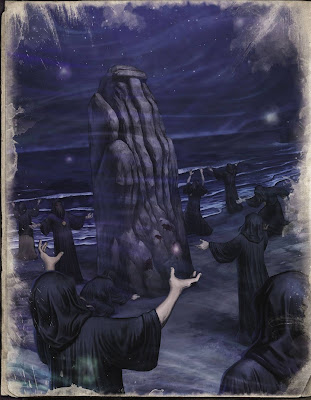 Human cultists can now be enhanced with Cthulhu’s Blessings, including various ‘bad touch’ abilities that inflict ice damage, severe pain or life-threatening mutations. Other new powers include hearing dreams or peering beyond the veil of reality. Also, not one, but two tentacle powers!
Human cultists can now be enhanced with Cthulhu’s Blessings, including various ‘bad touch’ abilities that inflict ice damage, severe pain or life-threatening mutations. Other new powers include hearing dreams or peering beyond the veil of reality. Also, not one, but two tentacle powers!
“Some living mummies may find that their minds, through near-constant contact with Cthulhu, become transposed by Cthulhu’s will.”
We get three monstrous Cultists, including the Thrall of Cthulhu. Something about the Thrall got to me, despite my long experience with cosmic horror, I think it was because they described the way it smelled.
Actual monsters include the untrustworthy Black Winged Ones, the energy-based Scarlet Ones (a bit like radioactive Mysterons, shout out in the comments if you get that reference), man-eating quasi-elephants, and giant sentient worms who have the most disgusting form of communication I’ve ever encountered.
The artefacts and spells provided are mostly for use in the three scenarios that follow. But we do get stats and powers for Cthulhu idols and game rules for non-Euclidean architecture! Fans will be very pleased.
Chapters Five, Six, and Seven: Scenarios
The last three chapters are all adventures, each featuring one of the new cults introduced in this book. Some general points about these:
The scenarios are very well laid out, with an introduction that explains everything going on, some useful background, descriptions of NPCs, a timeline, and a character relationship map. The scenarios themselves are broken down by scene, with each scene including copious notes and advice for the Keeper, and explanations on where to go next.
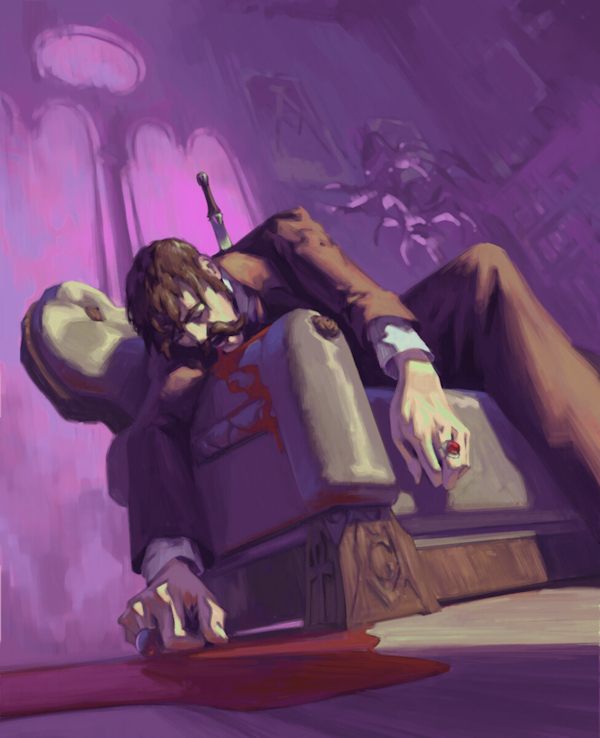 Chaosium has learned from the rise of the Gumshoe System—an RPG ruleset based around the idea that PCs should always find the clues needed to push a plot forward, because whoever wrote a story where the detective doesn’t get the clue? (Whereas, in early investigative RPGs, it was quite possible for the entire party to fail their rolls to find the hidden document, and the whole game could grind to a halt.) Almost every scene in these three scenarios comes with one or more “leads”. Leads are divided into “obvious” and “obscure”—PCs can discover obvious leads just by looking around, asking obvious questions and so on, obscure leads require rolls or some lateral thinking. Obvious leads are all that is needed to get from one end of the plot to the other, obscure leads provide alternate paths and extra information.
Chaosium has learned from the rise of the Gumshoe System—an RPG ruleset based around the idea that PCs should always find the clues needed to push a plot forward, because whoever wrote a story where the detective doesn’t get the clue? (Whereas, in early investigative RPGs, it was quite possible for the entire party to fail their rolls to find the hidden document, and the whole game could grind to a halt.) Almost every scene in these three scenarios comes with one or more “leads”. Leads are divided into “obvious” and “obscure”—PCs can discover obvious leads just by looking around, asking obvious questions and so on, obscure leads require rolls or some lateral thinking. Obvious leads are all that is needed to get from one end of the plot to the other, obscure leads provide alternate paths and extra information.
The writers are clearly veterans of investigative games, and well versed in players’ shenanigans. Many scenes include advice on what to do if the PCs try to call the police, refuse to trust a seemingly helpful character, or turn to violence. Cultists don’t necessarily meet violence with violence—they may call the authorities themselves, pull strings with police contacts, kidnap the PCs, threaten loved ones, or even resort to legal action.
The advice throughout is eminently practical and sensible.
“As always, the Keeper should read through the adventure ?and be familiar with the events and characters before running the game. Some non-player characters (NPCs) have complex belief systems that they are enthusiastic about sharing with the investigators. It is important for the Keeper to understand these beliefs so they may correctly portray these characters and give the investigators (and players) something to think about.”
The scenarios are flexible, with multiple paths through them and various possible outcomes. They can be used as one-shots, or the start of a longer campaign.
There are tons of handouts: notes, letters, press-cuttings, maps. Everything you need to create the sense of a real investigation.
Without getting too much into spoiler territory, here are some details about each individual scenario. Again, even this information is probably too much for players who wish to play through these scenarios.
 “Loki’s Gift”
“Loki’s Gift”
“Theater is a powerful art form. A visceral means for people to communicate complex ideas and feelings in a contained period of time. Such expression shows us aspects of our life and society in ways that we might not have noticed or previously understood. Theater can change us, so we are no longer the person we were before the performance. Loki’s Gift attempts to take this powerful art form and make it into a tool. A tool wielded by a Cthulhu cult.”
Set in the Victorian era and featuring the Elevated Order of Morpheus. A grieving father hires the investigators to discover the reason behind his son’s suicide. The son was a composer and had been working on the score for an avant-garde play. This scenario includes an artists’ collective, a charming villain, mass debauchery, and a terrible trap. It could be accused of being somewhat rail-roady, but that is because of the actions of NPCs working to create a specific outcome, so I will forgive it. The cast is well drawn, their motivations are well-articulated and effective.
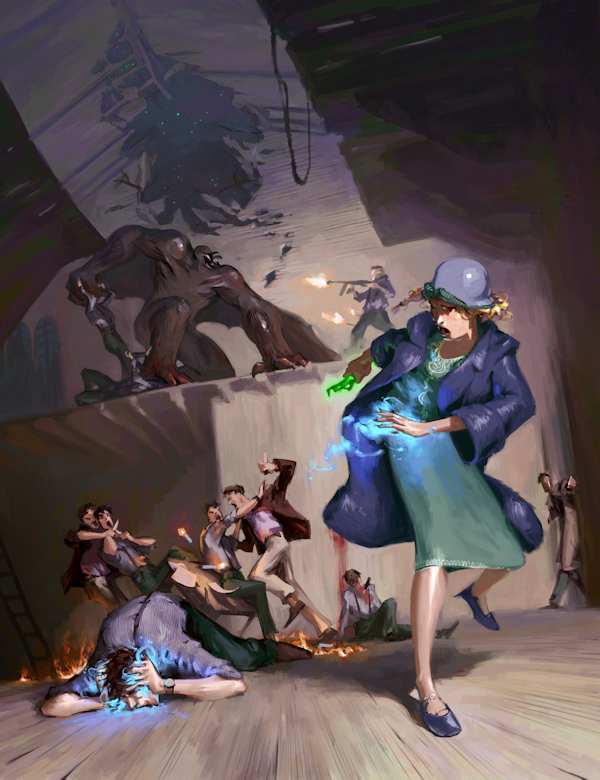 “Angel’s Thirst”
“Angel’s Thirst”
“Seeing the world from their “normal” viewpoint, the investigators are challenged to perceive a place where the id rules supreme.”
Set in 1920s Los Angeles and featuring the Society of the Angelic Ones. A daughter begs for aid in locating her missing father. Includes organised crime, violent brawls, curious mysteries, good old-fashioned library research, treachery, Mythos monsters, a dread ritual, and a weird, occult Art Deco temple. Timing is key here, with different locations yielding up different clues and encounters depending on when in the timeline the PCs visit them (or revisit them). This is perhaps the most classic Call of Cthulhu of the three scenarios and provides a good starting point for new groups.
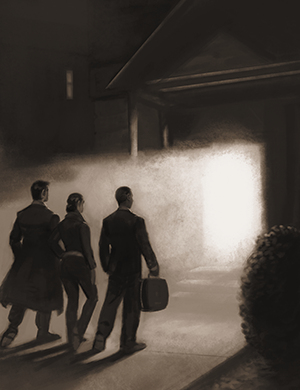 “A God’s Dream”
“A God’s Dream”
“This scenario’s themes are about humanity’s miniscule role in the universe and an individual’s total insignificance in the grand scheme of things. Power is an illusion. Choice is a dream. Control is non-existent.”
Set in the modern day. A private investigator asks the PCs to help him with a job that’s gotten weird. He’s been looking into a haunted house whose owners are trying to buy up the rest of the street. The buyers are the Church of Perfect Science. Things get a lot weirder from there. Features ancient witch-ghosts, break-ins, travel through time and space, and the terrifyingly potent machinations of Cthulhu himself. This scenario provides a very interesting take on the Call of Cthulhu RPG, with a very specific kind of horror based around unseen manipulation and existential dread. It would work extremely well as a one-shot but might need more careful handling and management of player buy-in if used as part of a campaign. (The writers have thought of this and provide alternatives and advice.)
Appendix
There are also three appendices.
Appendix A: Inspiration
A list of inspirational media. Includes some interesting films and TV. Much of it is about cults in general, rather than direct Lovecraftian themes.
Appendix B: Mythos Tomes
A list of Mythos tomes (books that shed light on the “truth” of reality and can damage the sanity of the reader), which contain reference to Cthulhu. Includes rules for skimming through a Mythos tome in search of a specific piece of information.
Appendix C: Collected Handouts
All scenario handouts are duplicated here, for ease of printing or photocopying.
Conclusion
This is a well-crafted, thoughtful, and very useful guide to adding Cthulhu cults to your games. For experienced Keepers who want to include Cthulhu himself in their games, this book provides everything you need to get started. Want to use the original Cthulhu stories? The cults and creatures have been statted up and are ready to go, with some interesting conflicts and goals baked into them.
Want something a bit fresher (albeit slimy)? Here are cults and scenarios for use in the gaslight, classic 1920s, and modern eras, with advice and ideas for expanding from there. Want your own cult (Cthulhu or otherwise)? Or wish the book provided cults for World War Cthulhu or Cthulhu Invictus? This book will tell you exactly how to build one.
Are you a new or aspiring Keeper? If you’re already familiar with the Call of Cthulhu Starter Set and/or the Keeper Rulebook, this is a great next step. The scenarios are excellent examples of how to lay out a mystery that people can play through, and the cult-building guide will show you how to build your own Lovecraftian organisation from start to finish. Even GMs who play other games will find the cult creation guide very handy for use in their own horror and mystery games, from Delta Green to Unknown Armies to Fate of Cthulhu.
However, if you just like cosmic horror and want to learn a bit more weird lore, then you won’t be getting the most out of this book and should look elsewhere. This is a practical GMing guide, not (just), a lore-book.
If you do want to make great cults to test your players, then go out and get this book, you won’t be disappointed.
If you’re new to Call of Cthulhu the RPG, or would like to know more about it, check out the following reviews:
- Bud’s RPG Review reviews the Call of Cthulhu Starter Set. Call of Cthulhu Starter Set for Call of Cthulhu 7th Edition by Chaosium—YouTube
- Reviews from R’lyeh reviews the original Call of Cthulhu the RPG. Reviews from R’lyeh: Review 1500: Call of Cthulhu (rlyehreviews.blogspot.com)
- Game Geeks reviews the current edition of Call of Cthulhu. Game Geeks #268 Call of Cthulhu 7th Edition by Chaosium Inc.—YouTube
- Or check out the many Call of Cthulhu Let’s Plays on The Calyx, a YouTube show created and presented by the very talented Becca Scott. With a fantastic rotating cast, it’s always entertaining, often hilarious, and a great way to learn about the game. I particularly recommend “The Crimson Letters” and “The Saturnine Chalice”. THE CALYX—Call of Cthulhu RPG Anthology Series—YouTube
- If you prefer podcasts, check out Let’s Plays by How We Roll About Us—HowWeRoll Podcast, and Ain’t Slayed Nobody Ain’t Slayed Nobody | Call of Cthulhu Podcast (aintslayednobody.com). Or go and meet some Good Friends of Jackson Elias for discussions of Call of Cthulhu, cosmic lore, and horror gaming Blasphemous Tomes—The home of The Good Friends of Jackson Elias, a podcast about Call of Cthulhu, horror films and horror gaming in general.
Disclaimer: I requested and received a free digital review copy of this book in return for an honest review.

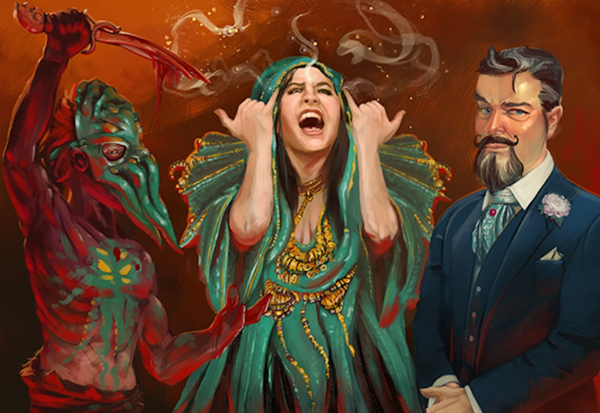
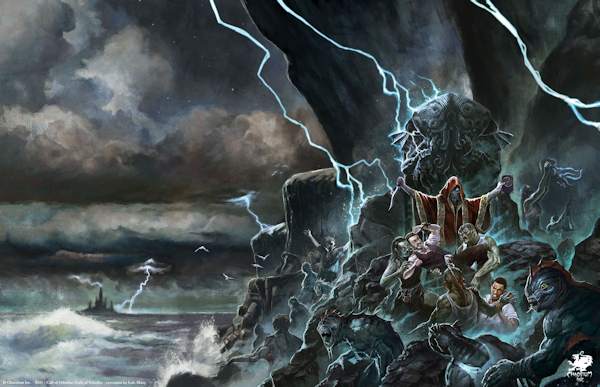

“radioactive Mysterons” – I understood that reference.
Excellent review. Seemed complete and if it is, then I’m disappointed! Chaosium did not include any other Mythos but Cthulhu? And what of the setting CTHULHU DARK AGES? Cthulhu Now hasn’t had an update in years, but that setting is included?